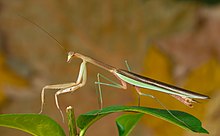| Chinese mantis | |
|---|---|

| |
| Adult male | |
| Scientific classification | |
| Domain: | Eukaryota |
| Kingdom: | Animalia |
| Phylum: | Arthropoda |
| Class: | Insecta |
| Order: | Mantodea |
| Family: | Mantidae |
| Subfamily: | Tenoderinae |
| Tribe: | Tenoderini |
| Genus: | Tenodera |
| Species: | T. sinensis
|
| Binomial name | |
| Tenodera sinensis (Saussure, 1871)
| |
| Synonyms | |
The Chinese mantis (Tenodera sinensis) is a species of mantis native to Asia and the nearby islands. In 1896, this species was accidentally introduced by a nursery tender at Mt. Airy near Philadelphia, United States.[2] Tenodera sinensis often is erroneously referred to as Tenodera aridifolia sinensis because it was at first described as a subspecies of Tenodera aridifolia, but Tenodera sinensis is now established as a full species.[3]
Tenodera sinensis feeds primarily on other insects, though adult females sometimes catch small vertebrates. For example, they have been observed feeding on hornets, spiders, grasshoppers, katydids, small reptiles, amphibians, and even hummingbirds.[4] Like most mantids, they are known to be cannibalistic. One study found that cannibalism occurs in up to 50% of matings.[5] These mantids have been observed eating the larvae of monarch butterflies, while discarding the entrails.[6]

- ^ "Archived copy". Archived from the original on 2014-10-13. Retrieved 2014-01-13.
{{cite web}}: CS1 maint: archived copy as title (link) Texas A&M University - ^ a b Blatchley, Willis Stanley (1920). Orthoptera of northeastern America: with especial reference to the faunas of Indiana and Florida. The Nature Publishing Company. pp. 122–123.
- ^ Ehrmann, R. 2002. Mantodea: Gottesanbeterinnen der Welt. Natur und Tier, Münster
- ^ "Praying Mantis Makes Meal of a Hummer". 2005-12-12. Archived from the original on 2005-12-12.
- ^ Brown, William D.; Barry, Katherine L. (2016). "Sexual cannibalism increases male material investment in offspring: Quantifying terminal reproductive effort in a praying mantis". Proceedings of the Royal Society B: Biological Sciences. 283 (1833). doi:10.1098/rspb.2016.0656. PMC 4936037. PMID 27358366.
- ^ "Chinese Mantis Guts Its Toxic Caterpillar Prey". 25 January 2013. Archived from the original on January 27, 2013.